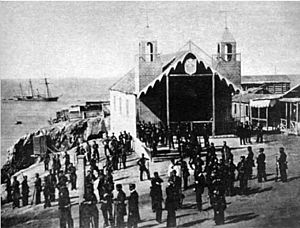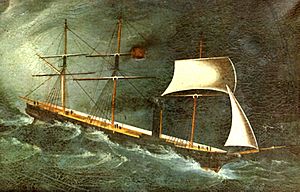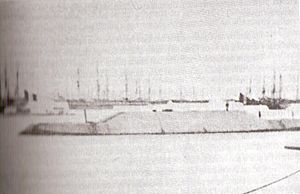Chincha Islands War facts for kids
Quick facts for kids Chincha Islands War |
|||||||
|---|---|---|---|---|---|---|---|
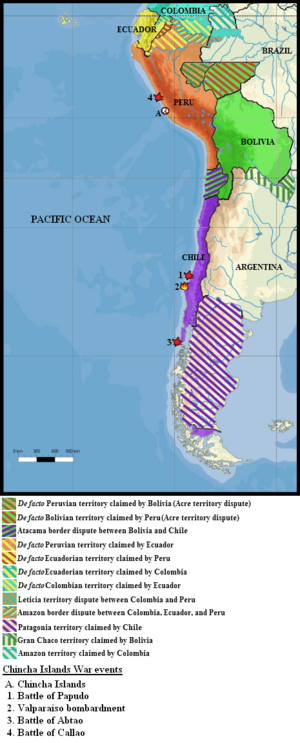 1865 South America during the Chincha Islands War. Orange: Peru. Green: Bolivia. Yellow: Ecuador. Blue-Green: Colombia. Purple: Chile. |
|||||||
|
|||||||
| Belligerents | |||||||
|
Nominal participation: |
|||||||
| Commanders and leaders | |||||||
| Casualties and losses | |||||||
| 300 | 700 | ||||||
The Chincha Islands War, also known as the Spanish–South American War, was a series of battles fought mostly at sea between Spain and its former colonies: Peru, Chile, Ecuador, and Bolivia. This conflict lasted from 1865 to 1879. The war began when Spain took control of the guano-rich Chincha Islands. Spain, led by Queen Isabella II, was trying to regain influence over its old South American territories. This war was important because it saw the use of new armored ships called ironclads. One famous ironclad, the Spanish ship Numancia, was the first to sail all the way around the world!
Contents
Why the War Started
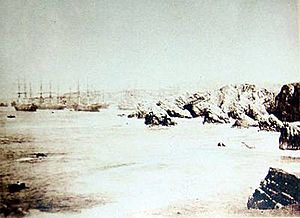
In the 1850s and 1860s, Spain was becoming a strong naval power. They were involved in colonial activities around the world, including places like Morocco and the Philippines.
In late 1862, Spain sent a scientific group to South America. Their secret goal was to check on money and legal claims of Spanish people living there. This group was led by Admiral Luis Hernández-Pinzón Álvarez. His ships included the frigates Triunfo and Resolución, the corvette Vencedora, and the schooner Virgen de Covadonga.
The Spanish ships arrived in Valparaiso, Chile, in April 1863. Spain and Chile had good relations. The ships were welcomed warmly. They then sailed to Peru. Even though Spain had not officially recognized Peru's independence, the ships were still welcomed in Callao. After a few weeks, they left for San Francisco, in the United States.
The Talambo Incident
On August 4, 1863, a fight happened at a farm called Talambo in Lambayeque, Peru. One Spaniard died, and four others were hurt.
When Admiral Pinzón heard about this, he returned to Peru in November. He demanded that Peru apologize and pay for the damages. Peru said it was a local police matter and no apology was needed. Spain then decided to also demand that Peru pay old debts from the Peruvian War of Independence. Spain sent a representative named Eusebio de Salazar y Mazarredo to talk with Peru.
Salazar arrived in March 1864. He was called a "Royal Commissary," which was an insult. A commissary was a title used for officials in colonies, not for ambassadors between independent countries. This made talks with Peru's Foreign Minister, Juan Antonio Ribeyro Estrada, fail.
Spain Takes the Chincha Islands
On April 14, 1864, Spain took over the Chincha Islands. This was because Peru refused to pay the money Spain demanded. The Chincha Islands were very important to Peru because they were rich in guano (bird droppings used as fertilizer). This guano made up almost 60% of Peru's government income.
Spanish sailors arrested the islands' governor and raised the Spanish flag. Spain thought controlling these islands would give them a strong bargaining chip. The Spanish fleet also blocked Peru's main ports. This stopped trade and made many people in Latin America angry. Spain expected Peru to offer little resistance. During the blockade, the Spanish ship Triunfo was accidentally destroyed by fire.
The new Spanish Prime Minister, Ramón María Narváez, did not like Pinzón's actions. He replaced him with Vice Admiral Juan Manuel Pareja. Pareja was born in Peru. His father had fought for Spain in Chile. Narváez soon changed his mind and sent four more warships to help the fleet in the Pacific.
Pareja arrived in Peru in December 1864. He started talks with General Manuel Ignacio de Vivanco, Peru's representative. They signed the Vivanco-Pareja Treaty on January 27, 1865. Many Peruvians felt this treaty was unfair to their country. The Peruvian Congress refused to approve it. This led to a rebellion, and Peru's President, Juan Antonio Pezet, was removed from power on November 7.
War Begins with Chile
Meanwhile, people in other South American countries like Bolivia, Chile, and Ecuador also became angry at Spain. They worried Spain wanted to rebuild its old empire. Because of this suspicion, when a Spanish ship stopped in a Chilean port for coal, Chile's President José Joaquín Pérez said coal was a war supply and could not be sold to a country involved in a conflict.
Spain saw Chile's refusal to sell coal as a sign that Chile was no longer neutral. This was made worse when two Peruvian ships carrying weapons and Chilean volunteers left Valparaiso for Peru. Vice Admiral José Manuel Pareja demanded harsh actions against Chile. He sent four wooden ships to Chile, while the Numancia and Covadonga stayed to guard Callao.
Pareja arrived in Valparaiso on September 17, 1865. He demanded that the Spanish flag receive a 21-gun salute. He made this demand the day before Chilean National Day (September 18). Chile refused, and war was declared a week later on September 24.
The new Spanish Prime Minister, Leopoldo O'Donnell, ordered Pareja to leave. But the Spanish admiral ignored the order. Since he had no troops to land, he decided to block Chile's main ports. This was hard to do because Chile has a very long coastline (about 1,800 miles). Blocking it would need a much bigger fleet than Pareja had. However, the blockade of Valparaiso caused a lot of economic damage. Even the United States and Great Britain, who were neutral, formally protested.
The Battle of Papudo
Even before Chile and Peru officially became allies, Spain suffered a big naval loss. This happened at the Battle of Papudo on November 26, 1865. The Chilean ship Esmeralda captured the Spanish schooner Covadonga. They took the crew as prisoners and seized important war papers. After this defeat, Commodore Casto Méndez Núñez took command of the Spanish fleet.
More Countries Join the Fight

On November 7, 1865, Peruvian President Juan Antonio Pezet was forced out of office. People were angry that he did not declare war on Spain and for signing the Vivanco-Pareja Treaty. His vice president, General Pedro Diez Canseco, took his place.
Diez Canseco also tried to avoid war with Spain, which led to his removal just 20 days later. On November 26, General Mariano Ignacio Prado, a leader of the nationalist movement, took power. His new government immediately supported Chile. They planned to declare war on Spain and restore Peru's national honor.
Chile and Peru officially formed an alliance against Spain on December 5, 1865. Peru declared war on Spain two days later. Chile's navy was not very strong. To help their ally, Peru sent a squadron of ships south, led by Captain Lizardo Montero. These ships included the frigates Amazonas and Apurímac.
Ecuador joined the alliance on January 30, 1866, by declaring war on Spain. Bolivia, led by General Mariano Melgarejo, also declared war on March 22, 1866. This meant all ports on South America's Pacific coast were closed to the Spanish fleet. Argentina and Brazil did not join because they were fighting in the Paraguayan War.
The Battle of Abtao
Spain's Admiral Mendez Núñez sent two of his strongest ships, the frigates Villa de Madrid and Reina Blanca, south. Their goal was to destroy the combined Chilean-Peruvian fleet. The Allied ships, led by Peruvian Captain Manuel Villar, were hiding in Abtao, a safe inlet in southern Chile. The Spanish ships arrived on February 7, 1866. They did not enter the inlet because they worried their large ships would get stuck in the shallow water. A long cannon battle happened, but it did not do much damage. Even though the Allied ships were anchored and some had their engines being fixed, they fought bravely. The Covadonga managed to fire over an island and hit the Spanish frigate Blanca several times. The battle ended without a clear winner. The Spanish left, not wanting to risk their ships in shallow waters or waste ammunition.
The Chilean ship Esmeralda was not at Abtao that day. It had gone to get coal. On its way back to Valparaiso, the Spanish fleet captured a Chilean steamboat, the Paquete del Maule. This ship was carrying sailors for Peru's new ironclads, the Huáscar and Independencia.
Valparaíso is Attacked
The Spanish could not attack land forces and had failed to fight the Allied ships at sea. The Spanish ships were alone, low on supplies, and losing hope. When Chile ordered all ships communicating with the Spanish fleet to be banned from Chilean ports, Admiral Mendez Núñez decided to punish the Allied ports. The Spanish fleet attacked and burned the town and port of Valparaiso on March 31. They destroyed Chile's merchant fleet. A total of 33 ships were burned or sunk. This caused huge damage to Chile's shipping industry. Even 12 years later, Chile's total ship tonnage was less than half of what it was in 1865.
The Battle of Callao
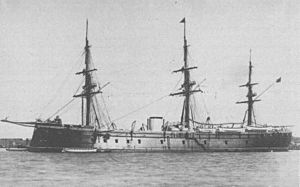
Admiral Mendez Núñez was unhappy about destroying defenseless targets like Valparaiso and the unclear result at Abtao. He decided to change his plan and attack a heavily defended port. He sailed for the Peruvian port city of Callao. The Battle of Callao happened on May 2. Both sides claimed victory. Peru said they stopped Spain from regaining power in South America and forced the Spanish fleet to leave. This was technically true, as Peruvian cannons fired the last shots. Spain claimed they had punished their former colony. However, Spanish guns only caused limited damage to Callao's defenses. Most of the cannons, artillery, and buildings in Callao were still standing after the battle.
What Happened After the War?
It's not clear if Spain truly planned to take back its old colonies. Many in South America thought Spain's actions, like taking the Chincha Islands, showed a long-term plan to regain control. However, the force Spain sent was just a small group of ships. They didn't have many troops to land. Their goal might have just been to take the islands for their valuable fertilizer as payment, and to regain some of Spain's pride. Whatever the reason, Spain found it impossible to stay. With all ports south of Colombia closed for coal and supplies, the Spanish fleet left the South American coast. They sailed away from the Chincha Islands and returned to Spain by way of the Philippines, completing a trip around the world.
Remembering the War
A street in Madrid, Spain, called calle del Pacífico ("Pacific street"), was named after this war. This street then gave its name to a neighborhood and a metro station.
Important Ships and Commanders
Here are some of the main ships and commanders involved in the war:
Spain
General Commanders
- Vice-Admiral Luis Hernández Pinzón (1863–1864)
- Vice-Admiral José Manuel Pareja (1864–1865)
- Rear-Admiral Casto Méndez Núñez (1865–1866)
Key Ships
- Numancia: A powerful ironclad frigate, one of the strongest ships in the world at the time.
- Villa de Madrid: A large screw-frigate.
- Almansa: Another screw-frigate that arrived just before the Battle of Callao.
- Reina Blanca: A screw-frigate.
- Berenguela: A screw-frigate.
- Resolución: A screw-frigate.
- Nuestra Señora del Triunfo: A screw-frigate, lost in an accidental fire.
- Vencedora: A steam-schooner.
- Virgen de Covadonga: A steam-schooner, captured by Chile.
Peru
General Commanders
- Captain Lizardo Montero
- Captain Manuel Villar
Key Ships
- Apurímac: A screw-frigate.
- Amazonas: A screw-frigate.
- Tumbes: A steam-schooner.
- Chalaco: A steamboat.
- Colón: A steamboat.
- Loa: An ironclad monitor (a type of warship).
- Victoria: An ironclad.
Chile
General Commanders
- Captain Juan Williams Rebolledo
Key Ships
- Esmeralda: A corvette (a small warship).
- Virgen de Covadonga: A steam-schooner, captured from Spain.
- Paquete del Maule: A transport ship, captured by Spain.
- Maipú: A steamer.
- Lautauro: A steamer, given by Peru to Chile.
Images for kids
See also
 In Spanish: Guerra hispano-sudamericana para niños
In Spanish: Guerra hispano-sudamericana para niños


